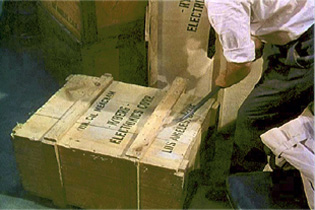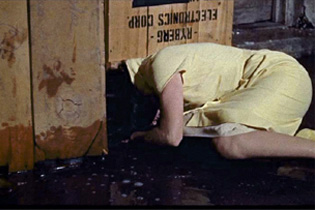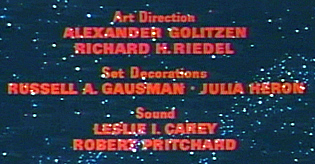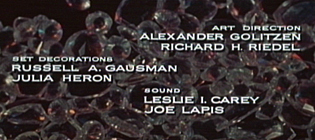Is Every Inadvertence Inadvertent?
May 2, 2005
(Why does Sara Jane crawl into a crate addressed to Ryberg Electronics? Was an Interociter delivered to the set of Imitation of Life?)
 How do we know whether something in a film is inadvertent or intended? That is, if we see something in a film, how do we know the director (or someone else) intended it to be there? At the heart of these questions lies the difference between narrative and documentary filmmaking. The auteur theory (in its extreme form) claims that everything in a film should be intended by the creator, the director. Cinema verité (again in an extreme form) claims that everything should be unintended, that the filmmaker should control nothing. But surely, there are many things in an "authored" film that are unintended - that are inadvertent or accidental - and many things in a verité documentary which are planned.
How do we know whether something in a film is inadvertent or intended? That is, if we see something in a film, how do we know the director (or someone else) intended it to be there? At the heart of these questions lies the difference between narrative and documentary filmmaking. The auteur theory (in its extreme form) claims that everything in a film should be intended by the creator, the director. Cinema verité (again in an extreme form) claims that everything should be unintended, that the filmmaker should control nothing. But surely, there are many things in an "authored" film that are unintended - that are inadvertent or accidental - and many things in a verité documentary which are planned.
This Island Earth was released in 1956. At the time it was the most expensive science fiction movie ever made.
The plot is far-fetched. Scientists are working in a laboratory, Ryberg Electronics, on a military base somewhere in southern California. One day they receive a catalogue in the mail. It could be a Sears Roebuck catalogue except that its pages are made out of metal and it is filled with pictures of ultra-sophisticated scientific devices - devices that the scientists have never seen. Col. Cal Meacham, the head scientist, orders the parts for one of the items in the catalogue - an Interociter. (For a comparison please see my note on the Interociter v. the Interrotron.)
A pile of crates arrives. Meacham and his assistant unpack, read the instructions, and assemble the Interociter. They plug it in and Exeter (Jeff Morrow) appears on the triangular screen. For whatever reason, Meacham and his assistant fail to recognize Exeter as an alien even though his head is weirdly shaped and much larger than it should be. Well, much larger than it should be if Exeter is supposed to be human. To make a long story short, Exeter, who really isn't such a bad guy after all, is recruiting Earth scientists in an attempt to save his dying planet, Metaluna. Exeter takes Meacham to Metaluna, but they arrive too late to save the planet. Meacham returns to Earth, Exeter commits suicide, and we are left with the thought that the fate of Metaluna may be a prefiguration of what will happen to our own planet.
 Imitation of Life, Douglas Sirk's last film, was released in 1959 - approximately three years after This Island Earth. There is a scene in Imitation of Life where Sara Jane (Susan Kohner), the not-quite-white daughter of Annie (Juanita Moore) is beaten by her boyfriend, Troy Donahue. The beating, which is shown in a series of reflections in a plate-glass window, ends in an alley. And there it is - a crate stamped on the side: "Ryberg Electronics". It is one of the same crates that arrive in This Island Earth.
Imitation of Life, Douglas Sirk's last film, was released in 1959 - approximately three years after This Island Earth. There is a scene in Imitation of Life where Sara Jane (Susan Kohner), the not-quite-white daughter of Annie (Juanita Moore) is beaten by her boyfriend, Troy Donahue. The beating, which is shown in a series of reflections in a plate-glass window, ends in an alley. And there it is - a crate stamped on the side: "Ryberg Electronics". It is one of the same crates that arrive in This Island Earth. What does this mean? If anything?
Why is the crate from This Island Earth in Imitation of Life?
Here are some of the possibilities that occur to me. Both Imitation of Life and This Island Earth were made by the same studio - Universal Pictures. After the completion of This Island Earth, the set decorators or art directors stored some of the props, including several crates that said Ryberg Electronics.
They were dressing the set for the Susan Kohner-Troy Donahue scene and someone pointed over at the Ryberg Electronics crate, and said: Get that crate and put it in the alley. The crate was useful, and the fact that it said Ryberg Electronics was of no consequence. Maybe no one even noticed it.
It's an inadvertence. It's purely accidental. Or is it?

 Here's another possibility that immediately comes to mind. The art director, Alexander Golitzen, really loved This Island Earth and wanted to put a reference to it in Imitation of Life. He may have even gone so far as to imagine that there were thematic or metaphorical connections between the two films. He could call attention to those possible connections by actually putting the Ryberg Electronics crate in the movie. Some credibility is lent to this version by the fact that the art directors and set decorators for This Island Earth and Imitation of Life were the same. The credits for both films read: art direction by Alexander Golitzen and Richard H. Riedel; set decoration by Russell A. Gausman and Julia Heron. If it wasn't Golitzen, it could have been Riedel or Gausman or Heron or one of their assistants. (Golitzen, legendary in his own right, was nominated for thirteen Oscars and won three for Spartacus, To Kill A Mockingbird and The Phantom of the Opera.) To be sure, their credits appear in dozens of Universal productions during the '50s - many of the films of Douglas Sirk and Jack Arnold, among others. So, the appearance of their names in the credits of both films is not so surprising.
Here's another possibility that immediately comes to mind. The art director, Alexander Golitzen, really loved This Island Earth and wanted to put a reference to it in Imitation of Life. He may have even gone so far as to imagine that there were thematic or metaphorical connections between the two films. He could call attention to those possible connections by actually putting the Ryberg Electronics crate in the movie. Some credibility is lent to this version by the fact that the art directors and set decorators for This Island Earth and Imitation of Life were the same. The credits for both films read: art direction by Alexander Golitzen and Richard H. Riedel; set decoration by Russell A. Gausman and Julia Heron. If it wasn't Golitzen, it could have been Riedel or Gausman or Heron or one of their assistants. (Golitzen, legendary in his own right, was nominated for thirteen Oscars and won three for Spartacus, To Kill A Mockingbird and The Phantom of the Opera.) To be sure, their credits appear in dozens of Universal productions during the '50s - many of the films of Douglas Sirk and Jack Arnold, among others. So, the appearance of their names in the credits of both films is not so surprising.
Or it could have been Douglas Sirk himself. Perhaps he loved This Island Earth and felt compelled to put this reference to it in this new film he was directing. It could have been Sirk who requested the crate. But what could have inspired this? Are there thematic and metaphorical themes in both films that obsessed him? Is this why Jeff Morrow, after appearing in This Island Earth, found his way into several Sirk films?
And you could imagine even more far-fetched explanations - the possibility that This Island Earth contains a warning. The aliens described in the movie are real, and they are involved in an attempt to save their dying planet at the expense of ours - Earth. Perhaps they have been signaling to each other using obscure references in mass-market movies. The visual reference to Ryberg Electronics in Imitation of Life could be an attempt to signal aliens or alien-sympathizers living on our planet. And when Ryberg Electronics appears in a third movie - assuming that it has not already happened - it will be only a matter of days, at most months, before "they" begin their assault on our planet.
My question is: How do you know - looking at just the films themselves - which interpretation is correct? How do we know whether the inclusion of the Ryberg Electronics crate in Imitation of Life was inadvertent or controlled? Whether it is devoid of meaning or whether it is redolent with meaning? Whether Sirk or his art directors wanted it there, or it ended up in the Sirk film purely by accident. What is in the images themselves that provides a clue as to whether they are intended or unintended - meaningless or meaningful?
(My thanks to Tim Onosko for telling me about the hidden connection between This Island Earth and Imitation of Life.)







